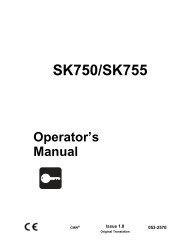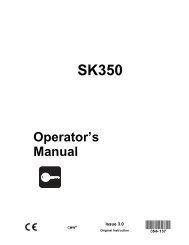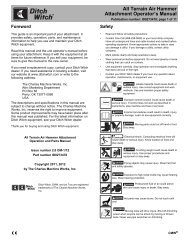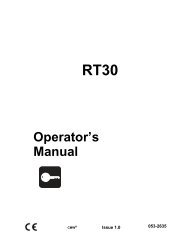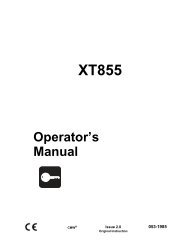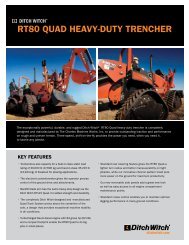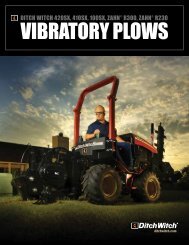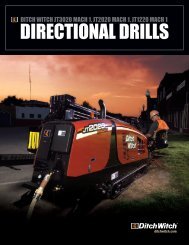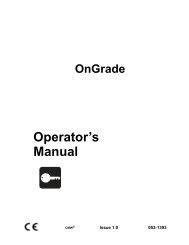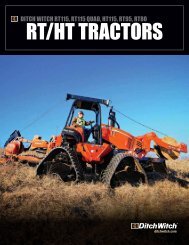FX30 Manual - Ditch Witch
FX30 Manual - Ditch Witch
FX30 Manual - Ditch Witch
You also want an ePaper? Increase the reach of your titles
YUMPU automatically turns print PDFs into web optimized ePapers that Google loves.
1.5.5. TIRE SIZE<br />
To maintain tire safety, purchase new tires that are the same size as the trailer's original tires or<br />
another size recommended by the manufacturer. Look at the tire information placard, the owner's<br />
manual, or the sidewall of the tire you are replacing to find this information. If you have any doubt<br />
about the correct size to choose, consult with your dealer.<br />
1.5.6. TIRE TREAD<br />
The tire tread provides the gripping action and traction that prevent your trailer from slipping or<br />
sliding, especially when the road is wet or icy. In general, tires are not safe and should be<br />
replaced when the tread is worn down to 1/16 of an inch. Tires have built-in treadwear indicators<br />
that let you know when it is time to replace your tires. These indicators are raised sections<br />
spaced intermittently in the bottom of the tread grooves. When they appear "even" with the<br />
outside of the tread, it is time to replace your tires. Another method for checking tread depth is to<br />
place a penny in the tread with Lincoln's head upside down and facing you. If you can see the top<br />
of Lincoln's head, you are ready for new tires.<br />
1.5.7. TIRE BALANCE AND WHEEL ALIGNMENT<br />
To avoid vibration or shaking of the trailer when a tire rotates, the tire must be properly balanced.<br />
This balance is achieved by positioning weights on the wheel to counterbalance heavy spots on<br />
the wheel-and-tire assembly. A wheel alignment adjusts the angles of the wheels so that they are<br />
positioned correctly relative to the trailer's frame. This adjustment maximizes the life of your tires.<br />
These adjustments require special equipment and should be performed by a qualified technician.<br />
1.5.8. TIRE REPAIR<br />
The proper repair of a punctured tire requires a plug for the hole and a patch for the area inside<br />
the tire that surrounds the puncture hole. Punctures through the tread can be repaired if they are<br />
not too large, but punctures to the sidewall should not be repaired. Tires must be removed from<br />
the rim to be properly inspected before being plugged and patched.<br />
1.5.9. TIRE FUNDAMENTALS<br />
Federal law requires tire manufacturers to place standardized information on the sidewall of all<br />
tires. This information identifies and describes the fundamental characteristics of the tire and also<br />
provides a tire identification number for safety standard certification and in case of a recall.<br />
1.5.9.1. UTQGS Information<br />
Treadwear Number - indicates the tire's wear rate. The higher the treadwear number is, the<br />
longer it should take for the tread to wear down. For example, a tire graded 400 should last twice<br />
as long as a tire graded 200.<br />
Traction Letter - indicates a tire's ability to stop on wet pavement. A higher graded tire should<br />
allow you to stop your car on wet roads in a shorter distance than a tire with a lower grade.<br />
Traction is graded from highest to lowest as "AA","A", "B", and "C".<br />
Temperature Letter - indicates a tire's resistance to heat. The temperature grade is for a tire that<br />
is inflated properly and not overloaded. Excessive speed, underinflation or excessive loading,<br />
either separately or in combination, can cause heat build-up and possible tire failure. From<br />
highest to lowest, a tire's resistance to heat is graded as "A", "B", or "C".



